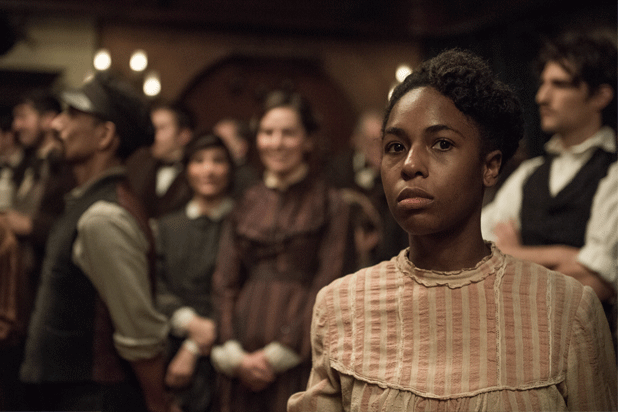Greta Gerwig’s ‘Little Women’ Proves Why #RepresentationMatters (Guest Blog)
Last week, a girlfriend asked me to join her for a 10:55 a.m. screening of “Little Women,” and I jumped at the chance. From the opening shot I was beguiled; the performances, the cinematography, the costumes, New England in all four glorious seasons, the love between these sisters who were familiar and yet altogether new — vibrant, modern, alive. My face hurt from smiling.
And then something peculiar happened.
Several minutes into the film, Jo March (played by a scintillating Saoirse Ronan) finds herself in a beer hall when a festive dance number materializes. She’s immediately swept up in the revelry, and the scene is so electric, you can’t help but feel that you are there. Winding and weaving through the crowd, the energy palpable, a blur of joyous faces. It brings to mind the steerage party scene in “Titanic,” (a film I saw four times in the theater, before Netflix was a thing). Such merriment and levity, it pulls you outside of yourself, if only for the briefest of moments.
But then unfortunately I was returned, hit with a jolt of envy. What, I wondered, must it have felt like to be a carefree, happy, white person dancing in a mid-19th century pub? Or even an actor hired to portray one?
Also Read: 'Harriet' Star Cynthia Erivo Responds to Stephen King's Diversity Tweet

Sony
It hit me hard. I had watched “Harriet” a few nights prior, and about three-quarters in I became aware that I could not recall having seen Cynthia Erivo smile once. And that gutted me. There was, as expected, much pain and darkness. And while I admired Erivo’s impassioned performance, I was depressed the following day. Consumed with thoughts of slavery and cruelty and injustice, and living in an era in which I might never have reason to smile.
I am Jamaican-Chinese, the child of immigrants who arrived in New York in the ’50s and ’60s. While this particular Black/Asian/British blend is not uncommon in the West Indies, I don’t often see it portrayed in American film. Over the years, I’ve come to gladly accept many black and/or Asian mixes as somewhat representative of me. And because slavery in the Caribbean is rarely if ever depicted in media here, I’ve adopted the American slave narrative as my own, our collective cross to bear.
So there I was, in a theater on a weekday morning, watching a gorgeously choreographed frolic, and thinking, “God, when do we get to be happy??” When do we get to be in movies that the Academy deems significant when we are not being beaten, raped, imprisoned or sold? When do we appear in period films when we are not downtrodden and suffering? Yes, there are exceptions, but not nearly often enough. “I just want to see us happy,” I thought.
And then, as if she somehow heard me, Greta Gerwig (not nominated for Best Director, because Hollywood) plucked a black actress out of the sea of otherwise underused black actresses yearning to be seen, and stuck her smack dab in the middle of the screen. Like magic. There she was, beaming in her fabulous costume, chocolate skin, in a crowded bar in 1800s Concord, Massachusetts, dancing her heart out. It gave me such joy, I cried.

Sony
They say #RepresentationMatters, and I think for many that message doesn’t resonate. But I felt it in that moment. And every other time a person of color appeared on the screen. Mostly in crowd scenes, or blurred in the background; once in a small exchange with Laura Dern’s Marmee. Their appearances were brief, but for me it was enough. Just the acknowledgment that we existed in that space, at that time. Inevitably, someone will argue that it may not be historically accurate. But “Little Women,” might I remind you, is fiction. Furthermore, one need only pick up a history book to realize African-Americans have lived in Massachusetts for centuries. During and before Louisa May Alcott’s time. Crispus Attucks, Sojourner Truth, Frederick Douglass, W.E.B. Du Bois… to name a few.
Yet to see us sprinkled throughout this inspired adaptation of a classic novel was a revelation.
I want more movies like this. I mean, yes, I will continue to show up for the “Queen & Slim”s, and the “Parasite”s, and the “Black Panther”s, and the “Crazy Rich Asians.” I will always support our varied stories. But I also want to see us mainstreamed. I want to see us in period pieces where we are not suffering. I want to see us simply existing and thriving in spaces we don’t often get to see — not because we weren’t there, but because the gatekeepers didn’t think to put us in the picture.
I’ve always thought #RepresentationMatters was a movement for kids. “Diversity and inclusion” benefits all of us, categorically. But “representation matters” in popular culture was the idea of curating diverse content for young people still forming their identities, whether about race, religion, ethnicity, gender, sexual preference or ability. It was for children being able to see themselves and all that they could be. For building their confidence and self-esteem. For letting them know the sky’s the limit. That is what I thought.
It was not for fully formed adults, slipping into a late-morning screening of an Oscar contender.
Until suddenly, it was.
Read original story Greta Gerwig’s ‘Little Women’ Proves Why #RepresentationMatters (Guest Blog) At TheWrap
